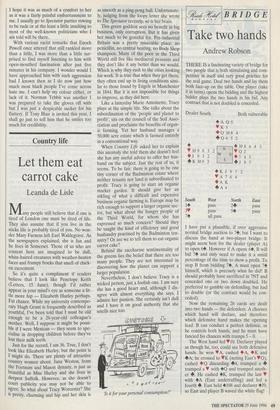BRIDGE
Take two hands
Andrew Robson
Dealer South 4 • 10 9 8 3 2
• J 9 3 2 +K 109 3
4A Q5 K 5 • Q 108 Q 6 5 Both vulnerable
4 2
4 10 8 6 4 3 IP Q J
• 7 6 5 +1 8 7
N w E
• K J 9 7 2
• A 7 6 4
• A K
+A 4
South West North East 14 pass 2+ pass 311 pass 54 pass 74 all pass I have put a plausible, if over aggressive normal bridge auction to 74; but I want to discuss the hand at two-player bridge. It might seem best for the dealer (player A) to open 64. However if A opens 64, B will bid 74 and only need to make it a small percentage of the time to show a profit. To stop B from bidding 74, A must open 74 himself, which is precisely what he did! B should probably have sacrificed in 7NT and conceded one or two down doubled. He preferred to gamble on defending, but had to double (or the contract would be con- ceded).
Now the remaining 26 cards are dealt into two hands — the defenders. A chooses which hand will declare, and therefore which defensive hand makes the opening lead. B can conduct a perfect defence, as he controls both hands, and he must have fancied his chances with trumps 5 – 0.
The West hand led IP10. Declarer played as though he, too, could see both defensive hands: he won IPA, cashed •A, •K and 4A; he crossed to IIK (noting East's 'IQ), cashed +0:2 discarding 44, trumped a + trumped a IF with 4Q and trumped anoth- er 4. He cashed 4K, trumped the last IP with 4A (East underruffing) and led a fourth 4. East held 4108 and declarer 4J9, so East and player B waved the white flag! THERE IS a fascinating variety of bridge for two people that is both stimulating and com- petitive in itself and very good practice for the real game. Deal two hands and lay them both face-up on the table. One player (take it in turns) opens the bidding and the highest bidder plays the two hands in his bid. Any contract that is not doubled is conceded.


























































 Previous page
Previous page